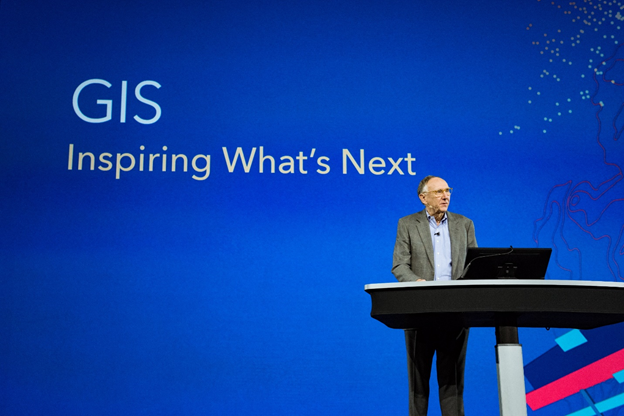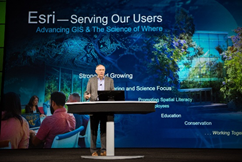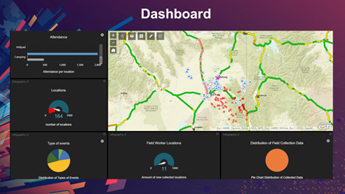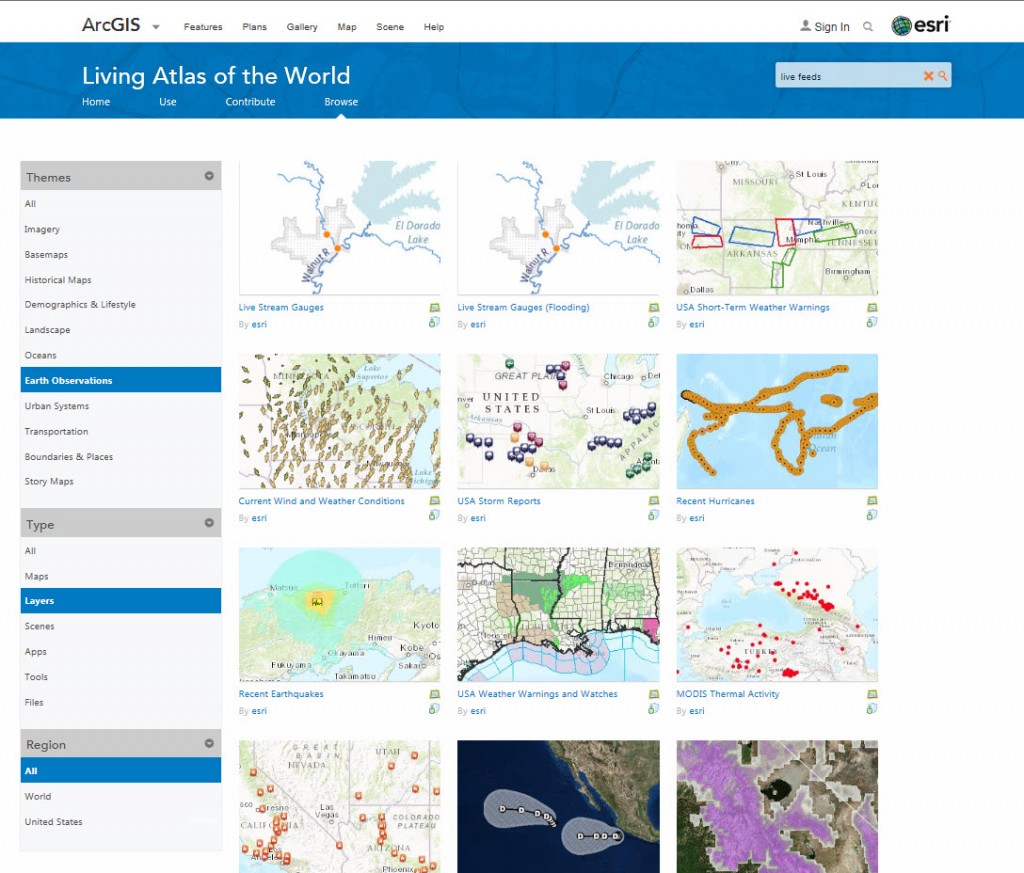By Mike Cox, Fire and EMS Industry Manager, Esri

The 38th Esri User Conference (Esri UC) was an incredible success. When nearly 18,000 Esri geographic information system (GIS) technology users gather for a week of learning, networking, and sharing ideas, the result can only benefit all involved. The content ranged from integrating data from “low earth orbit” satellites to dealing with a total solar eclipse “where the sun don't shine”.
This was my first User Conference since becoming an employee of Esri, and while I had attended the Esri UC previously as a user, my role this year provided a new perspective on the event. It was humbling to see the commitment of Esri personnel to our user community. Our only focus is to support our users, to see them succeed, and to serve. It is through this servant role that we see the incredible accomplishments of our users. For those of us in the public safety industry, these accomplishments mean saving lives, preserving property, and protecting the environment. The 2018 Esri UC had multiple examples of GIS leveraged to do just that—maintaining safe communities and protecting our neighbors.
For the public safety team, the event started with the National Security and Public Safety Summit (NSPSS) @ Esri UC. The theme this year was Prepare for the New Normal—explore new ways to overcome increasingly complex and unpredictable threats and hazards. This two-day preconference event had its largest attendance to date. Over 450 defense, law enforcement, fire, emergency medical, and emergency management personnel gathered for presentations about the successful use of GIS.

These NSPSS presentations covered topics including responding to wildfires, managing significant events such as the Super Bowl and the NCAA Final Four tournament, and sharing data with multiple agencies to coordinate preparations for and response to disasters. Local, state, federal, and international agencies demonstrated how GIS is used to prevent, assess, and respond to incidents. As an example, the European Union (EU) Satellite Centre presented on the use of satellite data to provide geospatial intelligence to a wide range of users within the European External Action Service and the EU member states. This presentation showcased the use of Esri technology, ranging from analysis performed on the desktop to the services being delivered through portals, from the management of the migration crisis to the support for the dismantlement of chemical weapons depots in Syria.

The theme of this year's Esri User Conference was Inspiring What's Next. As always, the main event began with Jack Dangermond presenting his vision at the Plenary Session. While his vision included where the technology is going, Dangermond started the week by having all in attendance consider what's next for our planet. What does that mean to individuals, families, and our communities? We live in a complex, interconnected world, and we can use geography to connect us. This constantly changing world creates many challenges—climate change, drought, deforestation, pollution, increasing urbanization, and many others. These challenges require us to fundamentally understand our world, as understanding precedes action. The Science of Where provides the framework and process for applying geographic knowledge that we can use to change our world. You can watch the 2018 Esri UC Plenary Session https://www.esri.com/videos/?event=594d5ac051b03b9718bde52b&title=Esri%20User%20Conference if you missed it earlier.

The Plenary Session maintained the Inspiring What's Next theme with a discussion of the emerging capabilities for the Esri platform. These capabilities include augmented reality, the Internet of Things, artificial intelligence, and machine learning. The increasing use of embedded devices in vehicles, clothing, and our environment—all with a geographic component—will impact our lives every day. With 3D capabilities providing a better understanding of our environment, first responders can—in seconds—identify the location of a person needing help, such as which floor in the building the person is in. GIS removes the technological complexities to allow us to solve real problems easily.
The latest release of ArcGIS Pro can help you visualize, edit, and analyze your geographic data in both 2D and 3D, providing full context to the area you are mapping. You are able to easily share your work—from mobile web scenes to paper maps—creating tailored experiences for different types of users. ArcGIS Pro 2.2 has many new features that are exciting, particularly when it comes to editing in 2D and 3D; performing quick visibility analysis; and sharing your 3D content on any device, anywhere, anytime.
Esri's ArcGIS Living Atlas of the World continues to evolve and provide multiple data sources for our users. One example of Living Atlas data is Sentinel-2 imagery for the entire planet. Each place on earth is reimaged every five days, and the data is updated daily. This service provides imagery and infrared views. The rich content of the Living Atlas is brought together in the Earth Systems Monitor. The monitor allows you to view climate data, real-time weather conditions, and urban development as well as a global human footprint map. You can review some of the Sentinel-2 capabilities at sentinel2explorer.esri.com/.
Thousands of attendees from over 140 countries gathered in the San Diego Convention Center to learn how the innovative use of GIS addresses the issues impacting our planet. Examples of this work included the following:
- Environmental modeling and assessment
- Planning and urban design
- Engineering and public works
- Utilities and telecommunications
- Public health and demographics
- Public safety and security
- Portal for ArcGIS, open data, and citizen engagement
- Cartography
- Story maps

The week continued with multiple technical workshops on subjects ranging from basic GIS capabilities to in-depth data analysis and application use. These technical workshops can be reviewed at esri.com/videos/watch?playlistid=PLaPDDLTCmy4Z27yCYMJkyxj3WHtFBW08l&title=2018-esri-uc-technical-wor....
One of the event highlights for Esri staff is the direct interaction and support we provided to our customers. For the public safety team, these exchanges primarily occurred in the Public Safety Neighborhood at the GIS Solutions Expo. This area allowed us to provide one-on-one demos, answer questions about solutions, and demonstrate solutions from our partners. There were also comprehensive presentations by our skilled staff in the Operations Platform for Safety/Security (OPS) Center Theater.
The Esri UC always focuses on our user community and its success. Throughout the conference, attendees could join other users during their presentations about the use of GIS. One of the most interesting sessions I was able to attend was about one community's effort to deal with "Where the Sun Don't Shine"! Trich Van Wagner, GIS manager for Bonneville County, Idaho provided an extremely entertaining presentation about how the county used GIS to manage the influx of visitors in the Idaho Falls area for the August 21, 2017, solar eclipse. Hundreds of thousands of people across the nation were vying for the best viewing spot, impacting localities across the nation.

Van Wagner and Bonneville County staff leveraged GIS to create incident maps and web apps for local government use. They mapped campsites and emergency response resources, and they used mobile applications such as Survey123 for ArcGIS and the ArcGIS environment to provide real-time incident data. This data was analyzed and communicated via story maps and dashboards. This presentation clearly demonstrated how The Science of Where helped provide a safe and efficient response to this significant special event.

Dangermond clearly stated that the goal of this year's Esri User Conference is unchanged from 38 years ago: to be together, learn from each other, share knowledge, and—from time to time—have a little fun. By all indications, we met this goal in 2018.
Please join us at the 2019 Esri User Conference, to be held July 8–12, 2019, at the San Diego Convention Center in San Diego, California. esri.com/en-us/about/events/uc/overview








